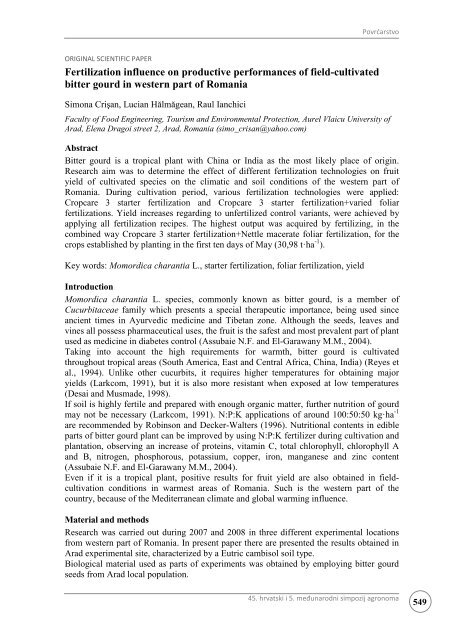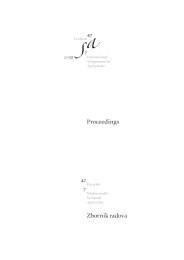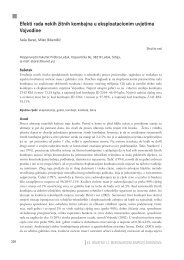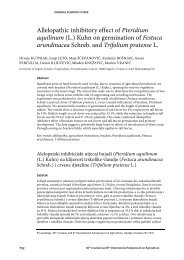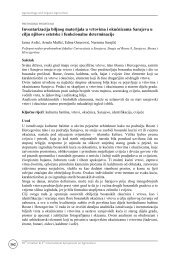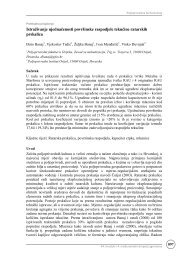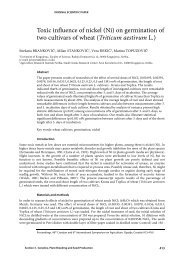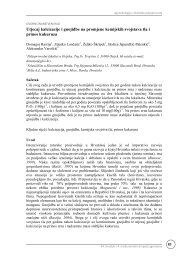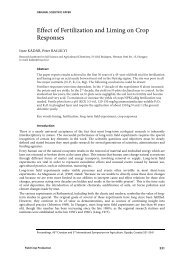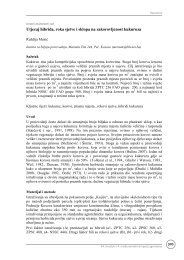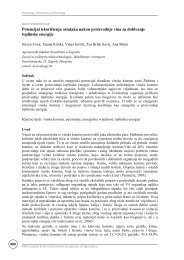SA2010 Paper Template - hr
SA2010 Paper Template - hr
SA2010 Paper Template - hr
Create successful ePaper yourself
Turn your PDF publications into a flip-book with our unique Google optimized e-Paper software.
ORIGINAL SCIENTIFIC PAPER<br />
Fertilization influence on productive performances of field-cultivated<br />
bitter gourd in western part of Romania<br />
Simona Crişan, Lucian Hălmăgean, Raul Ianchici<br />
Povrdarstvo<br />
Faculty of Food Engineering, Tourism and Environmental Protection, Aurel Vlaicu University of<br />
Arad, Elena Dragoi street 2, Arad, Romania (simo_crisan@yahoo.com)<br />
Abstract<br />
Bitter gourd is a tropical plant with China or India as the most likely place of origin.<br />
Research aim was to determine the effect of different fertilization technologies on fruit<br />
yield of cultivated species on the climatic and soil conditions of the western part of<br />
Romania. During cultivation period, various fertilization technologies were applied:<br />
Cropcare 3 starter fertilization and Cropcare 3 starter fertilization+varied foliar<br />
fertilizations. Yield increases regarding to unfertilized control variants, were achieved by<br />
applying all fertilization recipes. The highest output was acquired by fertilizing, in the<br />
combined way Cropcare 3 starter fertilization+Nettle macerate foliar fertilization, for the<br />
crops established by planting in the first ten days of May (30,98 t·ha -1 ).<br />
Key words: Momordica charantia L., starter fertilization, foliar fertilization, yield<br />
Introduction<br />
Momordica charantia L. species, commonly known as bitter gourd, is a member of<br />
Cucurbitaceae family which presents a special therapeutic importance, being used since<br />
ancient times in Ayurvedic medicine and Tibetan zone. Although the seeds, leaves and<br />
vines all possess pharmaceutical uses, the fruit is the safest and most prevalent part of plant<br />
used as medicine in diabetes control (Assubaie N.F. and El-Garawany M.M., 2004).<br />
Taking into account the high requirements for warmth, bitter gourd is cultivated<br />
t<strong>hr</strong>oughout tropical areas (South America, East and Central Africa, China, India) (Reyes et<br />
al., 1994). Unlike other cucurbits, it requires higher temperatures for obtaining major<br />
yields (Larkcom, 1991), but it is also more resistant when exposed at low temperatures<br />
(Desai and Musmade, 1998).<br />
If soil is highly fertile and prepared with enough organic matter, further nutrition of gourd<br />
may not be necessary (Larkcom, 1991). N:P:K applications of around 100:50:50 kg·ha -1<br />
are recommended by Robinson and Decker-Walters (1996). Nutritional contents in edible<br />
parts of bitter gourd plant can be improved by using N:P:K fertilizer during cultivation and<br />
plantation, observing an increase of proteins, vitamin C, total chlorophyll, chlorophyll A<br />
and B, nitrogen, phosphorous, potassium, copper, iron, manganese and zinc content<br />
(Assubaie N.F. and El-Garawany M.M., 2004).<br />
Even if it is a tropical plant, positive results for fruit yield are also obtained in fieldcultivation<br />
conditions in warmest areas of Romania. Such is the western part of the<br />
country, because of the Mediterranean climate and global warming influence.<br />
Material and methods<br />
Research was carried out during 2007 and 2008 in t<strong>hr</strong>ee different experimental locations<br />
from western part of Romania. In present paper there are presented the results obtained in<br />
Arad experimental site, characterized by a Eutric cambisol soil type.<br />
Biological material used as parts of experiments was obtained by employing bitter gourd<br />
seeds from Arad local population.<br />
45. <strong>hr</strong>vatski i 5. međunarodni simpozij agronoma<br />
549
550<br />
Vegetable Growing<br />
Land preparation included autumn deep ploughing and spring harrowing. Basic<br />
fertilization was accomplished in autumn, using organic manure (30 t·ha -1 of decomposed<br />
manure incorporated by ploughing).<br />
Field crops were established by planting the seedlings cultivated in pots in greenhouses, in<br />
t<strong>hr</strong>ee different periods: first ten days of May, second ten days of May and first ten days of<br />
June. Planting was manual with 40-45 days old seedlings and with 4-5 well formed leaves,<br />
obtaining a density of 14286 plants/ha. For supporting the plant, during vegetation a 2,2 m<br />
tall trellis was used.<br />
At planting moment a starter fertilization was applied using a dose of 300 kg·ha -1 Cropcare<br />
3 fertilizer. During cultivation period various fertilization technologies were applied:<br />
Cropcare 3 starter fertilization, Cropcare 3 starter fertilization + Volldunger Linz Classic<br />
0,3% foliar fertilization, Cropcare 3 starter fertilization + Agriplant 2 0,6% foliar<br />
fertilization, Cropcare 3 starter fertilization + water diluted 1:20 Nettle macerate foliar<br />
fertilization. Application interval for all foliar fertilizations was 10-14 days.<br />
Cropcare 3 or Cropcare 10-10-20 is a complex mineral chlorineless fertilizer recommended<br />
both in starter and phasial fertilizations, especially for chlorine sensible, planted crops. Its<br />
chemical composition (%) is: N-10; P2O5-10; K2O-20; CaO-4; MgO-4; S-11; B-0,15; Cu-<br />
0,1; Fe-0,1; Mn-0,7; Mo-0,01; Zn-0,1. Volldunger Linz Classic is an water soluble<br />
complex microelements fertilizer with following composition (%): N-14; P2O5-7; K2O-21;<br />
MgO-1; microelements (B, Cu, Fe, Mn, Zn)-1. Agriplant 2 or Agriplant 12-5-24 is also an<br />
water soluble complex microelements fertilizer, used both for fertirrigation and foliar<br />
nutrition: N-12; P2O5-5; K2O-24; MgO-2; B-0,01; Cu-0,01; Fe-0,05; Mn-0,05; Mo-0,001;<br />
Zn-0,01 (%). Nettle macerate was prepared as follows: plants were cut before flowering<br />
stage and water soaked (10 l water per 1 kg of nettle), letting the pot in the sun for 12-14<br />
days and shaking solution in the morning and in the evening, for first t<strong>hr</strong>ee days; after<br />
filtering, obtained macerate was 1:20 water diluted and used for foliar nutrition.<br />
Bifactorial experiment was 3 x 5 type with 15 variants. Experimental factors presented the<br />
following graduations: A factor – planting moment – a1 May1-3th, a2 May 18-20th and a3<br />
June 4-6th; B factor – applied fertilization – b1 unfertilized, b2 Cropcare 3 starter<br />
fertilization, b3 Cropcare 3 starter fertilization + Volldunger Linz Classic 0,3% foliar<br />
fertilization, b4 Cropcare 3 starter fertilization + Agriplant 2 0,6% foliar fertilization, b5<br />
Cropcare 3 starter fertilization + water diluted 1:20 Nettle macerate foliar fertilization.<br />
Experiment was placed in belts arranged subdivided plots, for the 15 variants being<br />
performed t<strong>hr</strong>ee randomized repetitions.<br />
For experimental data processing and interpretation it was used Analysis of Variance<br />
(ANOVA) statistical method (Saulescu and Saulescu, 1967). The significance of individual<br />
differences related with control values was determined using least significant difference<br />
(LSD) procedure and represented as follows: * - significant positive, ** - highly significant<br />
positive, *** - very highly significant positive and o-significant negative, oo - highly<br />
significant negative, ooo - very highly significant negative, respectively.<br />
Results and discussion<br />
Analyzing obtained yields, as an average for 2007 and 2008 experimental years (Graph 1),<br />
one can observe that the yield of bitter gourd fruit were influenced both of fertilization<br />
technology and planting moment.<br />
Analyzing the influence of planting moment on fruit yield (Table 1), very highly<br />
significant results were determined by planting the seedling, both in the first ten days of<br />
May and in the second ten days of May, yield benefits relative to control Wt 1 (first ten<br />
days of June planting moment) being of 11,90 t·ha -1 and 7,51 t·ha -1 , respectively.<br />
45 th Croatian & 5 th International Symposium on Agriculture
Table 1. Influence of fertilization and planting moment on the yields of bitter gourd<br />
(Momordica charantia L.) fruit (2007-2008)<br />
Yield (t•ha -1 )<br />
35<br />
30<br />
25<br />
20<br />
15<br />
10<br />
5<br />
0<br />
22,98<br />
30,76<br />
27,03<br />
24,87<br />
30,98<br />
27,32<br />
17,23<br />
26,80<br />
23,15<br />
May 1-3th May 18-20th June 4-6th<br />
Planting moment<br />
19,44<br />
28,01<br />
22,93<br />
11,54<br />
18,41<br />
15,71<br />
12,41<br />
19,04<br />
15,42<br />
Unfertilized<br />
Povrdarstvo<br />
Cropcare 3 starter fertilization<br />
Cropcare 3 starter fertilization +<br />
Volldunger Linz foliar<br />
fertilization<br />
Cropcare 3 starter fertilization +<br />
Agriplant 2 foliar fertilization<br />
Cropcare 3 starter fertilization +<br />
Nettle macerate foliar<br />
fertilization<br />
Average<br />
Graph 1. Yield of bitter gourd (Momordica charantia L.) fruit (2007-2008)<br />
Applied fertilization resulted in the highest yield value of 26,01 t·ha -1 at V5 variant where<br />
was applied Cropcare 3 starter fertilization + water diluted 1:20 Nettle macerate foliar<br />
fertilization, realizing in this way a very highly significant increase of 8,76 t·ha -1 relative to<br />
control Wt 1 (unfertilized variant). By applying Cropcare 3 starter fertilization, a very<br />
highly significant yield increase of 8,07 t·ha -1 relative to Wt 1 was also obtained, and a<br />
significant increase of 3,43 t·ha -1 relative to variants average, control Wt 2. V3 variant<br />
(Cropcare 3 starter fertilization + Volldunger Linz Classic 0,3% foliar fertilization)<br />
obtained a highly significant yield increase of 4,71 t·ha -1 reffering to Wt 1. The variant<br />
where was applied Cropcare 3 starter fertilization + Agriplant 2 0,6% foliar fertilization<br />
(V4) lead to no significant difference, from the viewpoint of fruit yield, relative to Wt 1.<br />
45. <strong>hr</strong>vatski i 5. međunarodni simpozij agronoma<br />
551
552<br />
Vegetable Growing<br />
Regarding to combined action of the two studied factors, very highly significant yield<br />
increases of 7,78 t·ha -1 and 8,00 t·ha -1 , 9,57 t·ha -1 and 10,78 t·ha -1 respectively, were<br />
obtained by applying both Cropcare 3 starter fertilization and Cropcare 3 starter<br />
fertilization + water diluted 1:20 Nettle macerate foliar fertilization to crops planted in the<br />
first ten days of May and in the second ten days of May, respectively. Highly significant<br />
yield benefits of 6,87 t·ha -1 and 7,50 t·ha -1 were achieved when used same fertilization<br />
technologies at crops planted in the first ten days of June.<br />
Related to control Wt 2 (variants average), significant positive yield differences of 3,87<br />
t·ha -1 and 5,08 t·ha -1 were achieved only when planted the seedling in the second ten days<br />
of May and applied a starter fertilization with Cropcare 3 and a combined Cropcare 3<br />
starter fertilization+Nettle macerate foliar fertilization, respectively. For the crops<br />
established by planting in the first ten days of May and in the first ten days of June, for all<br />
applied fertilizations, yield differences presented no significance regarding control Wt 2.<br />
Conclusions<br />
Bitter gourd (Momordica charantia L.) field-cultivation is possible in the soil and climatic<br />
conditions of western part of Romania.<br />
Best fruit yields were obtained, in both 2007 and 2008 experimental years, when planting<br />
method for crops establishment was used in the first ten days of May.<br />
Yield increases relative to unfertilized control variants were achieved by applying various<br />
fertilization technologies, as follows: Cropcare 3 starter fertilization, Cropcare 3 starter<br />
fertilization + Volldunger Linz Classic 0,3% foliar fertilization, Cropcare 3 starter<br />
fertilization + Agriplant 2 0,6% foliar fertilization, Cropcare 3 starter fertilization + water<br />
diluted 1:20 Nettle macerate foliar fertilization.<br />
In both experimental years and also as their average, the highest fruit yields were acquired<br />
when applied Cropcare 3 starter fertilization and Cropcare 3 starter fertilization + water<br />
diluted 1:20 Nettle macerate foliar fertilization, respectively.<br />
References<br />
Assubaie N.F. and El-Garawany M.M. (2004). Evaluation of some important chemical<br />
constituents of Momordica charantia cultivated in Hofuf, Saudi Arabia. Journal of<br />
Biological Sciences, 4(5): 628-630.<br />
Desai U.T. and Musmade A. M. (1998). Pumpkins, squashes and gourds. Handbook of<br />
vegetable science and technology: production, composition, storage and processing. Ed.<br />
Salunkhe D.K. and Kadam S. S., 273-298. New York, USA: Marcel Dekker.<br />
Larkcom J. (1991). Oriental vegetables: the complete guide for garden and kitchen, 232.<br />
London, Great Britain: John Murray.<br />
Reyes M.E.C., Gildemacher B.H., Jansen G.J. (1994). Momordica L. In: Plant Resources of<br />
South-East Asia: Vegetables, Ed. Siemonsma J. S. and K. Piluek, 206-210. Wageningen, The<br />
Netherlands: Pudoc Scientific Publishers.<br />
Robinson R.W. and Decker-Walters D.S. (1996). Cucurbits. CAB International, 226. New<br />
York, USA.<br />
Saulescu N.A. and Saulescu N.N. (1967). Campul de experienta, Ed. Agro-silvica, 181-194.<br />
Bucuresti, Romania.<br />
45 th Croatian & 5 th International Symposium on Agriculture


